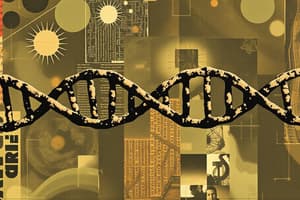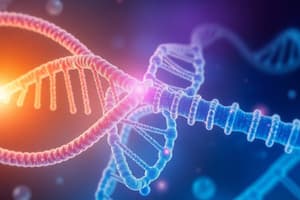Podcast
Questions and Answers
What is the result of tRNA binding to the A site during translation?
What is the result of tRNA binding to the A site during translation?
Gene mutations can only have negative effects on an organism.
Gene mutations can only have negative effects on an organism.
False
What initiates the termination phase of translation?
What initiates the termination phase of translation?
A stop codon appearing in the A site
A ______ mutation occurs when a base is inserted or deleted from a gene.
A ______ mutation occurs when a base is inserted or deleted from a gene.
Signup and view all the answers
Match the types of mutations with their examples:
Match the types of mutations with their examples:
Signup and view all the answers
What is the primary role of RNA polymerase during transcription?
What is the primary role of RNA polymerase during transcription?
Signup and view all the answers
During transcription in eukaryotes, enzymes are involved in splicing the mRNA after it is synthesized.
During transcription in eukaryotes, enzymes are involved in splicing the mRNA after it is synthesized.
Signup and view all the answers
What signals the start of protein synthesis?
What signals the start of protein synthesis?
Signup and view all the answers
The process of transcription produces _____ from a DNA template.
The process of transcription produces _____ from a DNA template.
Signup and view all the answers
Match the following terms with their correct descriptions:
Match the following terms with their correct descriptions:
Signup and view all the answers
Which of the following describes the direction of translation?
Which of the following describes the direction of translation?
Signup and view all the answers
All codons have corresponding tRNA anticodons.
All codons have corresponding tRNA anticodons.
Signup and view all the answers
What is the function of GTP during the initiation of translation?
What is the function of GTP during the initiation of translation?
Signup and view all the answers
What is the process known as when DNA is replicated in a way that preserves one original strand in each new double helix?
What is the process known as when DNA is replicated in a way that preserves one original strand in each new double helix?
Signup and view all the answers
The enzyme Helicase is responsible for creating covalent bonds between nucleotides during DNA replication.
The enzyme Helicase is responsible for creating covalent bonds between nucleotides during DNA replication.
Signup and view all the answers
What is the role of DNA Ligase during DNA replication?
What is the role of DNA Ligase during DNA replication?
Signup and view all the answers
During transcription, the strand of DNA that is copied is called the ______ strand.
During transcription, the strand of DNA that is copied is called the ______ strand.
Signup and view all the answers
Match the following enzymes with their functions in DNA replication:
Match the following enzymes with their functions in DNA replication:
Signup and view all the answers
What is the direction of synthesis for the leading strand during DNA replication?
What is the direction of synthesis for the leading strand during DNA replication?
Signup and view all the answers
In prokaryotes, mRNA undergoes processing before it is translated into proteins.
In prokaryotes, mRNA undergoes processing before it is translated into proteins.
Signup and view all the answers
What is the flow of genetic information as described in the central dogma?
What is the flow of genetic information as described in the central dogma?
Signup and view all the answers
Study Notes
DNA Replication
- DNA replicates during interphase, before mitosis.
- Meselson and Stahl, in 1957, demonstrated semi-conservative replication using California Institute of Technology.
- Experiment confirmed that replication follows a semi-conservative process.
- Unwinding is performed by the enzyme helicase, which breaks hydrogen bonds between bases.
- RNA primer binds to the old DNA strand.
- DNA polymerase III adds new nucleotides to the exposed strand in a 5' to 3' direction.
- Leading strand is continuous, lagging strand forms Okazaki fragments (discontinuous).
- DNA polymerase I removes RNA primers and replaces them with DNA nucleotides.
- DNA ligase joins Okazaki fragments.
Transcription
- DNA holds instructions for everything in the body but remains in the nucleus.
- Nucleus protects DNA, it's only exposed during mitosis.
- RNA is required to carry information from DNA to the rest of the cell.
- Strand transcribed is the anti-sense strand; the unused strand is the sense strand.
- mRNA is complementary to the anti-sense strand and acts as a RNA copy of the sense strand.
- Prokaryotes have uninterrupted gene sections, no processing needed.
- Eukaryotes have interrupted gene sections, requiring modifications after transcription.
- In eukaryotic cells, a promoter region identifies the DNA strand as anti-sense.
- Promoter is a short DNA sequence enabling RNA polymerase to attach.
- RNA polymerase attaches to the promoter and opens the DNA to begin transcription.
- Ribonucleoside triphosphates use hydrogen bonds and base pairings to build the new RNA strand.
- RNA polymerase also brings energy for building.
- Transcription bubble moves from the promotor area to the terminator region.
- Terminators detach RNA polymerase from the DNA, now refered to as mRNA.
- Splicing in eukaryotes removes noncoding regions (introns) from the mRNA.
Translation
- Codons within mRNA are used to create proteins.
- Translation changes the DNA language into protein language and occurs in a 5' to 3' direction.
- 64 possible codons, 3 have no tRNA anticodon (stop codons).
- Start codon (AUG) signals beginning of polypeptide chain, codes for methionine.
- Initiation: start codon (AUG) is at 5' end of mRNA, tRNA attaches to it (methionine).
- Small ribosomal unit attaches to mRNA, looking for start codon.
- Large ribosomal unit combines with the small one to form a translation initiation complex.
- Initiation factors require GTP for attachment of the initiation complex.
- Elongation: tRNA brings amino acids to the ribosome and a codon.
- Elongation Factors assist in binding to the A site.
- Ribosomes catalyze formation of peptide bonds (adjacent amino acids joined).
- Ribosomes move along mRNA, translating codons to protein/polypeptides.
- Polysome is a mRNA ribosome structure.
- Each tRNA brings a specific amino acid, attaching to A site, translocation to P site.
- Empty tRNA moves to the E site.
- Termination: stop codon appears in the A site.
- Release factor binds to the A-site.
- Hydrolysis of the bond linking tRNA to the polypeptide chain frees the polypeptide.
- Ribosome splits and separates from the mRNA.
Mutations
- Chromosomal mutations: Homologous pairs don't divide evenly during mitosis and meiosis, result in more or fewer chromosomes (46).
-
Gene mutations: Permanent changes in the DNA sequence of a gene.
- Point mutation: One base pair is changed.
- Frameshift mutation: A base is inserted or deleted, altering the reading frame of the gene.
- Gene mutations can be beneficial or non-beneficial.
- Examples of mutations include sickle-cell anemia, cystic fibrosis, Tay-Sachs disease, and Down syndrome.
Studying That Suits You
Use AI to generate personalized quizzes and flashcards to suit your learning preferences.
Description
This quiz covers crucial concepts of DNA replication and transcription. Understand the processes involved in DNA replication, including the roles of various enzymes and the semi-conservative model. Additionally, explore how RNA transcription occurs within the nucleus to transport genetic information.




